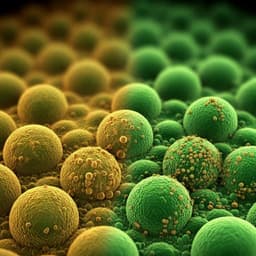
Agriculture
Breeding progress for pathogen resistance is a second major driver for yield increase in German winter wheat at contrasting N levels
H. Zetzsche, W. Friedt, et al.
Discover how breeding advancements are enhancing pathogen resistance and boosting yields in German winter wheat, shedding light on sustainable practices. This groundbreaking research was conducted by Holger Zetzsche, Wolfgang Friedt, and Frank Ordon.
~3 min • Beginner • English
Introduction
The study addresses how breeding progress in pathogen resistance has contributed to yield increases in German winter wheat under contrasting nitrogen (N) inputs and fungicide use. Wheat yields have increased globally, aided by improved resistance, yet major fungal pathogens—stripe/yellow rust (Puccinia striiformis f.sp. tritici), leaf rust (Puccinia triticina), powdery mildew (Blumeria graminis f.sp. tritici), and Fusarium head blight (Fusarium spp.)—remain significant constraints, capable of causing severe yield losses. Nitrogen fertilization can exacerbate disease severity and its effects vary by pathogen and environment. In Germany and Western Europe, recent yield stagnation has been linked to agronomic and climatic factors. Despite general agreement that resistance has improved over the past decades, quantitative assessments of resistance gains and their yield impact across input levels were lacking. Objectives: quantify breeding progress in resistance to major fungal pathogens and its effect on grain yield in relation to (i) N fertilization, (ii) fungicide treatment, and (iii) year of cultivar release using a historically representative German cultivar panel.
Literature Review
The paper synthesizes prior work indicating: (1) global yield gains of 1–2% per year over the past 50 years linked to improved resistance and management; (2) continued threat of cereal rusts, powdery mildew, and Fusarium head blight in temperate regions; (3) recent changes in P. striiformis populations (“Warrior”/“Kranich” races) increasing yellow rust risk, potentially amplified by climate change; (4) N fertilization often increases severity of yellow rust and leaf rust, and can favor powdery mildew under dense canopies; (5) FHB resistance is quantitative, controlled by major and minor QTL with environmental influence; effects of N on FHB are inconsistent across studies; (6) German wheat breeding has delivered genetic yield gains, with earlier studies reporting 25–51 kg ha−1 a−1 and relative gains of ~0.66–1.16% a−1 depending on intensity; (7) durable quantitative resistance genes (e.g., Lr34/Yr18, Lr46, Lr67/Lr68, Yr17) contribute to partial resistance, but many race-specific R genes have been overcome; (8) fungicides and resistant cultivars have historically mitigated epidemics. The study positions itself to quantify resistance trends and yield effects across input regimes in a unified field design.
Methodology
Plant material: 178 German winter wheat cultivars released between 1965 and 2013 (Bundessortenamt) selected for economic/agronomic importance, encompassing the subset used by Voss-Fels et al.
Experimental site/design: Julius Kühn Institute, Quedlinburg, Germany (Chernozem, silty loam, pH 7.1). Three seasons: 2014/15, 2015/16, 2016/17 with above-average temperatures and spring/summer drought in 2015 and 2017. Randomized incomplete block design; yield plots 4.5 m²; two replicates per treatment × cultivar. Four treatments combining N rate and fungicide regime: T1 (110 kg N ha−1, no fungicide; inoculated), T2 (110 kg N ha−1 + fungicide; non-inoculated), T3 (220 kg N ha−1, no fungicide; inoculated), T4 (220 kg N ha−1 + fungicide; non-inoculated). Sowing density 330 seeds m−2. Herbicide applied post-emergence. N applied as calcium ammonium nitrate up to three times (BBCH 23–25, 24–31, 33–45), adjusted for soil N; N timing partly delayed in drought years. Growth regulators applied twice (CCC 720; Medax Top). Fungicide programs (Capalo, Adexar, Prosaro) applied three times in T2 and T4 between April–June, keeping foliar diseases ≤1% (FHB absent; PM up to 4% on some susceptible cultivars in 2017). Insecticide applied per standard recommendations.
Pathogens/inoculation: Artificial inoculations in T1/T3 with mixed races of Puccinia striiformis (Warrior, Warrior(-), Oakley v7/Kranich, Triticale aggressive), Puccinia triticina (isolates 77WxR, Tommil, 167/76wxr, 4083), and Fusarium culmorum (Fc46). Rusts applied mid-April (PS; 5–10°C, BBCH 23–30) and mid-May (PT; 15–25°C, BBCH 33–40) using oil-spore suspensions via ULVA+ sprayer; 0.2 g spores per liter Isopar M; 400 m² per liter coverage. F. culmorum inoculated twice at flowering (BBCH 63–69) with ~3×10^5 conidia mL−1 aqueous suspensions; ≥80% humidity. Powdery mildew infection by natural inoculum.
Phenotyping: Disease severity recorded ~4 times per season for foliar diseases (YR, LR, PM) and twice for FHB. Percent infected tissue estimated; FHB index combined incidence × severity. Area under disease progress curve (AUDPC) computed; converted to Average Ordinate (AO) scaled by monitoring period. “Fungal sum” = AO(YR)+AO(LR)+AO(PM)+AO(FHB). Yield traits: grain yield (GRY, adjusted to 14% moisture) from whole plots; thousand kernel weight (TKW) from ~500 seeds via MARVIN analyzer; ears per square meter (ESM) by row counts; kernels per spike (KPS) derived from yield, TKW, spike number; harvest index (HI) from oven-dried subsamples (65→105°C); aboveground biomass (BM) from GRY and HI.
Statistics: Descriptive stats, orthogonal contrasts (LSmeans contrasts) for treatment effects; factorial ANOVA (PROC MIXED, SAS 9.4 via JMP 14.0) with N and plant protection as fixed factors; genotype and year as random. Treatment-specific adjusted means (LSmeans) per cultivar used for correlation (PROC CORR), PCA (PROC FACTOR), and bivariate regressions relating GRY to diseases and year of release (YoR). Partial bivariate analyses stratified cultivars into five YR quantile classes (YR1<4.0455%, YR2 4.0455–6.1509%, YR3 6.1509–9.1852%, YR4 9.1852–13.242%, YR5 13.242–31%) to dissect LR effects independent of YR.
Key Findings
- Disease prevalence and N effects:
- Three-year mean AO infection: YR 7.8±6.8% leaf area; LR 6.9±4.9%; PM 4.9±3.4%; FHB 2.6±1.8% ear area.
- Increasing N (110→220 kg ha−1; T1 vs T3) significantly increased susceptibility: YR +7.7%, LR +23.6%, PM +23.3%, FHB +33.3%.
- Genotype and year effects highly significant for all diseases; G×Y significant for all; G×N and G×N×Y significant only for FHB.
- Yield and components:
- Mean GRY across treatments 6.4±2.0 t ha−1; TKW 34.6±5.9 g; KPS 38.7±11.7; ESM 492±84 m−2; BM 17.8±3.6 t ha−1; HI 0.34±0.06.
- Plant protection increased GRY by +40.9%, BM +20.8%, TKW +20.0%, KPS +17.3%, ESM +1.1%, HI +15.9%.
- Higher N increased BM (+4.3%) and ESM (+2.4%) but decreased TKW (−8.8%), HI (−8.6%), and GRY (−3.4%) overall due to elevated disease and drought; under protection, GRY rose modestly (T2 7.36 vs T4 7.69 t ha−1).
- Year significantly affected GRY and components; 2016 highest GRY (7.8 t ha−1), 2015 (drought) lowest (5.2 t ha−1).
- Disease–yield relationships:
- Strong negative correlations between GRY and diseases; Fungal sum vs GRY r = −0.67 (110 N) and −0.76 (220 N), indicating ~50% of yield variance explained by combined disease severity.
- GRY vs YR: r = −0.80 (110 N), −0.86 (220 N); GRY vs FHB: r = −0.42, −0.64; GRY vs PM: r = −0.60, −0.36.
- LR vs GRY weak overall due to competition with YR; partial correlation at low YR (YR1) r ≈ −0.37; declines with higher YR classes.
- YR and LR negatively correlated (r = −0.40 to −0.45), indicating competition; YR correlated positively with PM and FHB.
- Estimated yield loss per 1% visible tissue damage (bivariate slope estimates):
- Fungal sum: 102 kg ha−1 (110 N) and 123 kg ha−1 (220 N).
- YR: 135 kg ha−1 (110 N) and 153 kg ha−1 (220 N).
- LR (YR1 class): 50 kg ha−1 (110 N) and 70 kg ha−1 (220 N).
- PM: 172 kg ha−1 (110 N) and 187 kg ha−1 (220 N).
- FHB: 217 kg ha−1 (110 N) and 305 kg ha−1 (220 N).
- Fungicide benefit vs disease pressure:
- Linear fits indicate fungicides alone contributed +0.64 t ha−1 at low N and +1.00 t ha−1 at high N as disease pressure (Fungal sum) increases; even resistant cultivars gained yield from fungicides.
- Breeding progress in resistance (slopes over YoR):
- Overall “Fungal sum” susceptibility decreased: −0.28% AO per year at 110 N; −0.30% at 220 N; relative improvement −0.93% a−1 and −0.88% a−1 (1965=100%).
- YR: −0.11% a−1 (110 N) and −0.13% a−1 (220 N); relative −1.00% and −1.07% per year.
- PM: −0.13% a−1 (110 N) and −0.14% a−1 (220 N); relative −1.49% and −1.39% per year.
- LR (in low YR class): −0.14% a−1 (ns) at 110 N; −0.18% a−1 at 220 N; relative −1.10% and −1.12% per year.
- FHB: small decrease −0.008% a−1 (ns) at 110 N; −0.012% a−1 at 220 N; relative −0.33% and −0.37% per year.
- Breeding progress in grain yield:
- GRY increased significantly across all treatments: average +38.3 kg ha−1 a−1 (T1 +38.1; T2 +34.1; T3 +45.6; T4 +35.5 kg ha−1 a−1).
- Relative annual GRY gains: overall +0.75% a−1; +0.55% a−1 with fungicides (T2, T4); +0.86% a−1 at low-input (T1); +1.33% a−1 at high N without fungicide (T3).
- Estimated contribution of improved disease resistance to yield gain: ~11% (+3.8 kg ha−1 a−1) at low N; ~28.5% (+10.1 kg ha−1 a−1) at high N.
Discussion
The findings quantify that modern German winter wheat cultivars have achieved simultaneous gains in genetic yield potential and disease resistance, and that these gains manifest across contrasting N inputs and protection regimes. Elevated N inputs intensified disease pressure (particularly for biotrophic pathogens and FHB), which in turn reduced yield components and final yield; nevertheless, breeding has delivered consistent reductions in susceptibility to YR, PM, and LR (under low YR), with smaller gains for FHB. The strong negative correlations between disease severity and yield, and the higher per-percent yield penalties at high N, explain why the largest relative yield progress without fungicides occurred at high N (T3). Competition between YR and LR complicates simple assessments of LR; partial analyses confirm substantial LR resistance gains when YR influence is controlled. The study supports the role of accumulated quantitative resistance (e.g., Lr34/Yr18/Lr46/Yr17 backgrounds) alongside the turnover of race-specific R genes, maintaining or improving field resistance despite evolving pathogen populations. Fungicides increased yields even in resistant cultivars, reflecting protection against subclinical infections and possible physiological benefits under stress; however, reliance on fungicides is reduced through genetic resistance gains. Overall, breeding for resistance is a major co-driver of yield gains, especially under intensive N where disease pressure is greatest.
Conclusion
Over five decades, German winter wheat breeding has significantly improved resistance to major fungal pathogens—most notably YR and PM, with measurable gains for LR under low YR pressure and smaller gains for FHB—while concurrently increasing grain yield across management intensities. Elevated N amplifies disease pressure, but relative resistance progress is similar across N levels, indicating durable genetic improvement. Disease resistance improvements contributed materially to yield gains, particularly at high N without fungicides, supporting more sustainable, environmentally friendly production with reduced pesticide reliance. Future work should prioritize enhancing quantitative resistance to FHB (given its large yield and quality impacts), further dissect genotype-by-N interactions for FHB, refine agronomic N strategies under increasing drought risk, and integrate genomic tools to stack durable resistance loci with high yield potential.
Limitations
- The three trial years included drought episodes (2015, 2017) which may have intensified stress and potentially overestimated genetic trends under low protection conditions.
- Fungicide efficacy was high but not absolute for PM in 2017; incomplete control can bias genetic gain estimates by differentially affecting older, susceptible cultivars.
- Variety ageing (gradual breakdown of race-specific resistance) and durable resistance gains are confounded in the no-fungicide variants; while partial analyses and comparisons mitigate this, precise partitioning remains challenging.
- FHB showed significant G×N interaction, indicating cultivar-specific responses to N; generalization across environments may be limited.
- The study was conducted at a single location; multi-location trials would improve generalizability across environments and pathogen populations.
Related Publications
Explore these studies to deepen your understanding of the subject.







